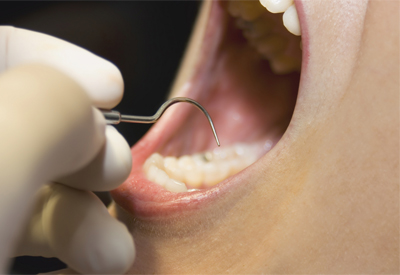Treatment options include Scaling and Root Planing and routine Periodontal Maintenance.
Scaling and Root Planing
Scaling and root planing treatment is most effective in the early stages of gum disease and can help to reduce periodontal pocket depths up to two or three millimeters on average.
Learn More About Gum Disease
Tooth and Bone Loss
Schedule Your Appointment Now!
Scaling and Root Planing
Periodontal disease occurs when bacteria that live below the gum line produce toxins which cause our bodies to destroy the bone that supports the teeth. There is no cure for periodontal disease. However, with early detection and timely treatment, we can help to stop the progression of this disease and prevent further bone and tooth loss.
Bacteria live within the plaque that accumulates in the mouth. When plaque is not removed properly, it can solidify into difficult to remove calculus, or tartar. The bacteria affect the gums by causing the tissues to pull away from the teeth, creating periodontal pockets. When periodontal disease is left untreated, it can cause irreversible bone and tooth loss.
Scaling and root planing is a nonsurgical periodontal treatment that is typically recommended when periodontal disease is diagnosed. Gingivitis is the first stage of gum disease, affects only the gum tissues, and is completely reversible if detected and treated early. If left untreated, however, it can progress into the deeper tissues and potentially cause bone and tooth loss. Many patients who have gingivitis or more advanced stages of periodontal disease often experience bleeding and sore gums when brushing, flossing, and eating.
The general steps of scaling and root planing treatment may include a local anesthetic to numb the areas that will be treated. Your doctor may suggest a form of sedation, if necessary. The treatment often requires hand instruments and an ultrasonic tool to remove the plaque and calculus accumulation. Your doctor or dental hygienist will use the instruments below the gum line to clean the roots of your teeth and smooth any rough surfaces. The goal of this deep cleaning process is to clear away plaque and tartar as well as smooth the surfaces of the teeth to encourage the gum tissues to reattach to the teeth.
It is necessary for scaling and root planing treatment patients to maintain their oral health and cleanliness after the procedure. Home maintenance is a major part of the healing process. The mouth needs to be free of food, debris, and plaque in order to keep the bacteria from causing further destruction. Thorough brushing and flossing will be required to ensure that the mouth is clean at all times. It is also important to discontinue the use of tobacco products. This will promote healing and reduce the risk of infection.
It is best for patients to be in a healthy condition and not have recently had a major surgery before receiving a scaling and root planing treatment. Your doctor will ask you about your medical history and discuss sedation options. After your treatment, your doctor may recommend an antimicrobial oral rinse containing chlorhexidine gluconate to rid your mouth of bacteria and reduce the risk of infection.
Scaling and root planing treatment is most effective in the early stages of gum disease and can help to reduce periodontal pocket depths up to two or three millimeters on average.
Periodontal Maintenance
Tooth Loss Risk Increases With Pocket Depth
Maintain Your Periodontal Health
Periodontal maintenance therapy is an ongoing program designed to prevent the progression of periodontal (gum) disease in the gum tissue and bone that supports the teeth. Periodontal maintenance is usually necessary for patients who have been diagnosed with and treated for periodontal disease.
Periodontal maintenance therapy is an ongoing program designed to prevent the progression of periodontal (gum) disease in the gum tissue and bone that supports the teeth. Periodontal maintenance is usually necessary for patients who have been diagnosed with and treated for periodontal disease.
Maintenance visits to the periodontist can help to prevent additional dental problems in the future, such as further bone and tooth loss. Treating the disease in its early stages can help to save you from not only oral and overall health problems, but also money!
Why is periodontal maintenance necessary?
Gum disease is caused by the bacteria found in plaque. The toxins produced by these bacteria cause our bodies to destroy the bone that supports the teeth. If plaque is not removed, it can harden and form calculus (tartar) that can exacerbate the periodontal problem.
Even someone dedicated to good oral hygiene will be unable to completely prevent the formation of all calculus on the teeth. Calculus forms when the minerals in the saliva harden, or calcify, the plaque on the teeth. Plaque is soft and sticky, and is continually forming. It is therefore important to ensure proper, thorough brushing and flossing on a daily basis to remove the plaque before it has the chance to solidify into calculus.
Flossing and brushing will help to keep the calculus formation to a minimum, but regular maintenance is needed to professionally remove what has accumulated. During your maintenance cleaning, the hygienist will evaluate and record your periodontal pocket depths and check for hidden periodontal problems.
How often do I need a maintenance visit?
Your periodontist will recommend how often you should have a periodontal maintenance visit. The frequency will be determined by the type of periodontal disease you have, the type of periodontal treatment you have had in the past, how you have responded to those treatments, and how quickly you accumulate plaque. The most important factor, however, is how dedicated you are to good hygiene at home.
Featured Services

Meet Our Dedicated and Talented
Periodontal Team
Schedule Your Periodontal Examination Today!
Appointments








